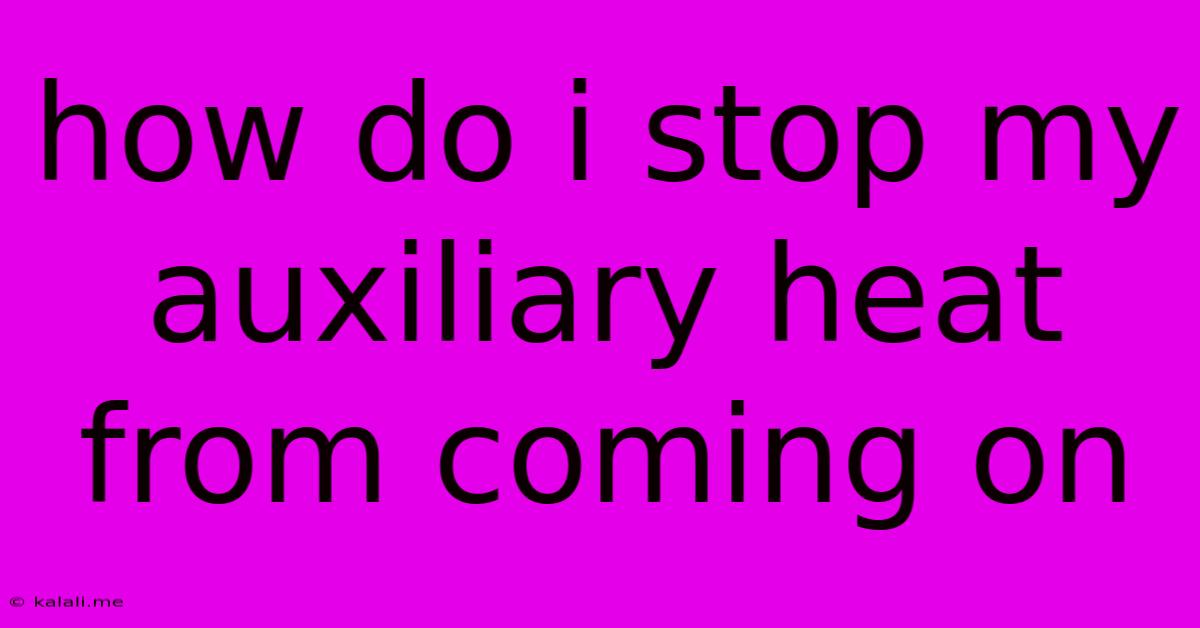How Do I Stop My Auxiliary Heat From Coming On
Kalali
May 31, 2025 · 3 min read

Table of Contents
How Do I Stop My Auxiliary Heat From Coming On? Troubleshooting Your Furnace's Backup System
Is your furnace's auxiliary heat kicking in too often, driving up your energy bills and leaving you feeling chilly? This common problem can stem from several issues, ranging from simple fixes to more complex repairs. This guide will help you diagnose why your auxiliary heat is constantly running and offer solutions to restore your heating system to optimal efficiency. Understanding how your system works is the first step towards a comfortable and cost-effective winter.
Understanding Auxiliary Heat
Auxiliary heat, often electric, acts as a backup system to your primary heating source, usually a gas furnace. It supplements the main heating element when the primary system struggles to reach the desired temperature. While helpful in extreme cold or during periods of peak demand, frequent activation indicates a problem needing attention. Common causes include:
Common Reasons for Frequent Auxiliary Heat Activation
-
Low Gas Pressure: This is a frequent culprit. Insufficient gas pressure prevents the main burner from igniting and achieving the target temperature efficiently. Your furnace will then rely on the electric auxiliary heat to compensate. This requires professional attention from a qualified HVAC technician to check gas lines and ensure proper pressure.
-
Faulty Igniter or Flame Sensor: These components are essential for igniting the gas burner. A malfunctioning igniter fails to create a spark, while a dirty or faulty flame sensor can prevent the burner from staying lit. Both scenarios lead to the auxiliary heat stepping in. Cleaning the flame sensor (with a wire brush) can sometimes solve the problem, but replacement may be necessary.
-
Dirty Air Filter: A clogged air filter restricts airflow, hindering the furnace's ability to heat your home efficiently. Restricted airflow forces the furnace to work harder, resulting in increased reliance on the auxiliary heat. Changing the filter regularly (check the manufacturer's recommendations) is crucial for maintaining optimal performance and efficiency.
-
Malfunctioning Blower Motor: If the blower motor isn't working correctly, it can disrupt airflow and impact heating efficiency. This forces the auxiliary heat to compensate. This issue typically requires professional assessment and potential motor repair or replacement.
-
Problems with the Heat Exchanger: A cracked or damaged heat exchanger is a serious issue that can compromise the safety and efficiency of your furnace. It necessitates immediate professional attention; operating a furnace with a faulty heat exchanger is dangerous and should never be attempted.
-
Thermostat Issues: While less frequent, a faulty thermostat might incorrectly register temperatures, leading to unnecessary activation of the auxiliary heat. Try replacing the batteries in your thermostat as a first step. If the issue persists, a new thermostat might be necessary.
Troubleshooting Steps: What You Can Do Yourself
Before calling a professional, try these simple checks:
-
Check and Replace the Air Filter: This is the easiest and most common solution. A clean filter drastically improves airflow and heating efficiency.
-
Inspect the Flame Sensor: Locate the flame sensor (usually a metal rod near the burner) and gently clean it with a wire brush. Ensure it’s free of dust and debris.
-
Check the Thermostat Batteries: A simple battery change can sometimes resolve temperature sensing errors.
When to Call a Professional
If you've tried these steps and the auxiliary heat continues to activate frequently, it's time to call a qualified HVAC technician. Issues like low gas pressure, a faulty igniter, or problems with the heat exchanger require professional expertise and specialized tools to diagnose and repair safely. Ignoring these problems can lead to safety hazards and higher energy costs.
Preventive Maintenance
Regular maintenance is key to preventing frequent auxiliary heat activation and ensuring your furnace operates efficiently. Schedule an annual inspection and tune-up from a professional HVAC technician to identify and address potential problems before they become major issues. This proactive approach will save you money in the long run and keep your home warm and comfortable throughout the winter months.
Latest Posts
Latest Posts
-
How To Use However In Middle Of Sentence
Jun 02, 2025
-
Hole Size For A 3 8 Bolt
Jun 02, 2025
-
Difference Between White Vinegar And White Wine Vinegar
Jun 02, 2025
-
What Size Nozzle Does The Anycubic Mega Pro Iuse
Jun 02, 2025
-
How To Idex A Removable Disk
Jun 02, 2025
Related Post
Thank you for visiting our website which covers about How Do I Stop My Auxiliary Heat From Coming On . We hope the information provided has been useful to you. Feel free to contact us if you have any questions or need further assistance. See you next time and don't miss to bookmark.